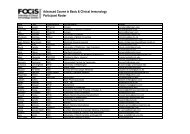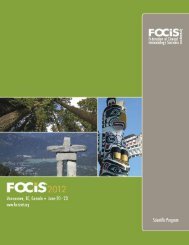Oral Presentations - Federation of Clinical Immunology Societies
Oral Presentations - Federation of Clinical Immunology Societies
Oral Presentations - Federation of Clinical Immunology Societies
Create successful ePaper yourself
Turn your PDF publications into a flip-book with our unique Google optimized e-Paper software.
S36 Abstracts<br />
values for antibody levels post-immunization. Serotypes 14,<br />
9V, and 4 appear high to low in hierarchy <strong>of</strong> responses.<br />
Discussion: Third generation multiplex assays for SSAPAb<br />
levels, without cross-reacting antibodies as confounders,<br />
indicate normal ranges after immunization are serotype<br />
specific with evidence <strong>of</strong> hierarchy and diversity. These data<br />
are consistent with serotype specific and non-specific pathways<br />
in antibody responses to pneumococcal capsular<br />
polysaccharides.<br />
doi:10.1016/j.clim.2007.03.278<br />
F.66 Differential Cytokine Response Induced by<br />
M. Avium and M. Abscessus in Human Macrophages<br />
is Mediated Through p38 MapKinase Signalling<br />
Pathway and Partially Dependent on TLR2<br />
Activation<br />
Elizabeth Sampaio, Senior Visiting Investigator, NIAID,<br />
NIH, Bethesda, MD, Houda Elloumi, Postdoctoral Fellow,<br />
NIH/NIAID, Bethesda, MD, Adrian Zelazny, Staff Scientist,<br />
NIH/NIAID, Bethesda, MD, Yvonne Shea, Laboratory<br />
Supervisor, NIAID/NIH, Bethesda, MD, Li Ding, Lab<br />
Manager, NIAID/NIH, Bethesda, MD, Steven Holland, Lab<br />
Chief, NIH/NIAID, Bethesda, MD<br />
Non-tuberculous mycobacteria (NTM) are ubiquitous<br />
environmental organisms that can cause chronic lung<br />
infection associated with primary or acquired immune<br />
deficiencies or in otherwise apparently normal individuals.<br />
Among NTM, M. avium is the most common cause <strong>of</strong><br />
mycobacterial infection. Moreover, M. abscessus is an<br />
emerging pulmonary pathogen responsible for the majority<br />
<strong>of</strong> infections by rapidly growing mycobacteria. It has been<br />
shown that the ability <strong>of</strong> mycobacteria to induce TNFα<br />
secretion is inversely related to their virulence. In this<br />
work, cytokine response and signaling pathways triggered<br />
by reference and clinical isolates <strong>of</strong> M. abscessus and M.<br />
avium (5 smooth and 5 rough morphotypes) were assessed<br />
in human PBMCs and monocytes. Mycobacteria-induced<br />
TNFα response is enhanced for M. abscessus (8535<br />
±1010 pg/ml) as compared to M. avium (2400±244 pg/<br />
ml, pb0.017) and no major differences were noted when<br />
compared colony morphologies within the same species.<br />
All mycobacterial strains were able to activate p38 MAP<br />
kinase phosphorylation and NF-kB translocation. Induction<br />
<strong>of</strong> TNFα was dependent on p38 MAPK signaling pathway<br />
since pre-incubation <strong>of</strong> cells with the p38 signaling<br />
inhibitor (SB203580) led to N80% reduction in cytokine<br />
secretion. In addition, treatment <strong>of</strong> cells with anti-human<br />
TLR2 antibodies showed TLR2 to be at least partially<br />
involved in signaling for M. abscessus as well. The present<br />
data indicate that M. avium is a more virulent pathogen<br />
than M. abscessus and elicits limited activation <strong>of</strong> cellular<br />
effector mechanisms, thereby escaping elimination.<br />
Accordingly, lung disease induced by NTM in nonpredisposing<br />
individuals may be associated with a yet uncharacterized<br />
underlying genetic defect.<br />
doi:10.1016/j.clim.2007.03.279<br />
F.67 Characterization <strong>of</strong> the Cellular Immunity in<br />
Patients Presenting Extensive Dermatophytoses Due<br />
to Trichophyton Rubrum<br />
Dewton Moraes Vasconcelos, MD, PhD, Department <strong>of</strong><br />
Dermatology, University <strong>of</strong> São Paulo Medical School, São Paulo,<br />
Brazil, Anna Cristina Collanieri, BSc, Department <strong>of</strong><br />
Dermatology, University <strong>of</strong> São Paulo Medical School, São Paulo,<br />
Brazil, Mauricio Domingues Ferreira, MD, PhD, Department <strong>of</strong><br />
Dermatology, University <strong>of</strong> São Paulo Medical School, São Paulo,<br />
Brazil, Tatiana Negri Santi-BSc, Department <strong>of</strong> Dermatology,<br />
University <strong>of</strong> São Paulo Medical School, São Paulo, Brazil, Anete<br />
S. Grumach, MD, PhD, Department <strong>of</strong> Dermatology, University<br />
<strong>of</strong> São Paulo Medical School, São Paulo, Brazil, Alexandre<br />
Almeida, MD, MSc, Department <strong>of</strong> Dermatology, University <strong>of</strong><br />
São Paulo Medical School, São Paulo, Brazil, Alberto Jose da<br />
Silva Duarte, MD, PhD, Department <strong>of</strong> Dermatology, University<br />
<strong>of</strong> São Paulo Medical School, São Paulo, Brazil<br />
Background: Dermatophytes cause infection in humans<br />
independent <strong>of</strong> the immunological status <strong>of</strong> the patient. In<br />
common to other infections the clinical features differ in<br />
immunodeficient patients. Dermatophytoses in cellular immunodeficient<br />
patients are usually less inflammatory, but some<br />
patients present pustular extensive lesions, frequently with<br />
follicular involvement.<br />
Objectives: Obtaining a reliable antigen by growth and<br />
purification <strong>of</strong> T. rubrum and to evaluate the immune<br />
reactivity “in vitro”, and quantify the immune response to<br />
the peptide YIIDTGIDID <strong>of</strong> T. rubrum. Methods: The fungal<br />
samples were obtained from the fungal library <strong>of</strong> the Institute<br />
<strong>of</strong> Tropical Medicine for antigen preparation, and the peptide<br />
was synthesized by EvoQuest. The lymphoproliferation assay<br />
was performed by tritiated thymidine incorporation and the<br />
cytokine quantifications by ELISA <strong>of</strong> culture supernatants.<br />
Results: The antigenic extract was efficient in the stimulation<br />
<strong>of</strong> cell cultures. The response to the peptide was also efficient<br />
and highly specific in sensitized controls. Despite most<br />
patients presented deficient responses, some presented<br />
normal lymphoproliferation. There was no difference<br />
between the cytokine secretion among patients and controls.<br />
doi:10.1016/j.clim.2007.03.280<br />
F.68 Evaluation <strong>of</strong> Cellular Responses to Rotavirus<br />
and NSP4 in Children during Natural Rotavirus<br />
Infection<br />
Jyoti Logani, Research Officer, Department <strong>of</strong> Pediatrics, All<br />
India Institute <strong>of</strong> Medical Sciences, New Delhi, India, Santosh<br />
Gupta, Research Associate, Department <strong>of</strong> Pediatrics, All India<br />
Institute <strong>of</strong> Medical Sciences, New Delhi, India, Shinjini<br />
Bhatnagar, Scientist, Department <strong>of</strong> Pediatrics, All India<br />
Institute <strong>of</strong> Medical Sciences, New Delhi, India, Pratima Ray,<br />
Scientist, Department <strong>of</strong> Pediatrics, All India Institute <strong>of</strong><br />
Medical Sciences, New Delhi, India, M.K. Bhan, Department <strong>of</strong><br />
Pediatrics, All India Institute <strong>of</strong> Medical Sciences, New Delhi,<br />
India<br />
Rotavirus (RV) is a major cause <strong>of</strong> gastroenteritis in young<br />
children leading to ∼611,000 deaths annually. Further




